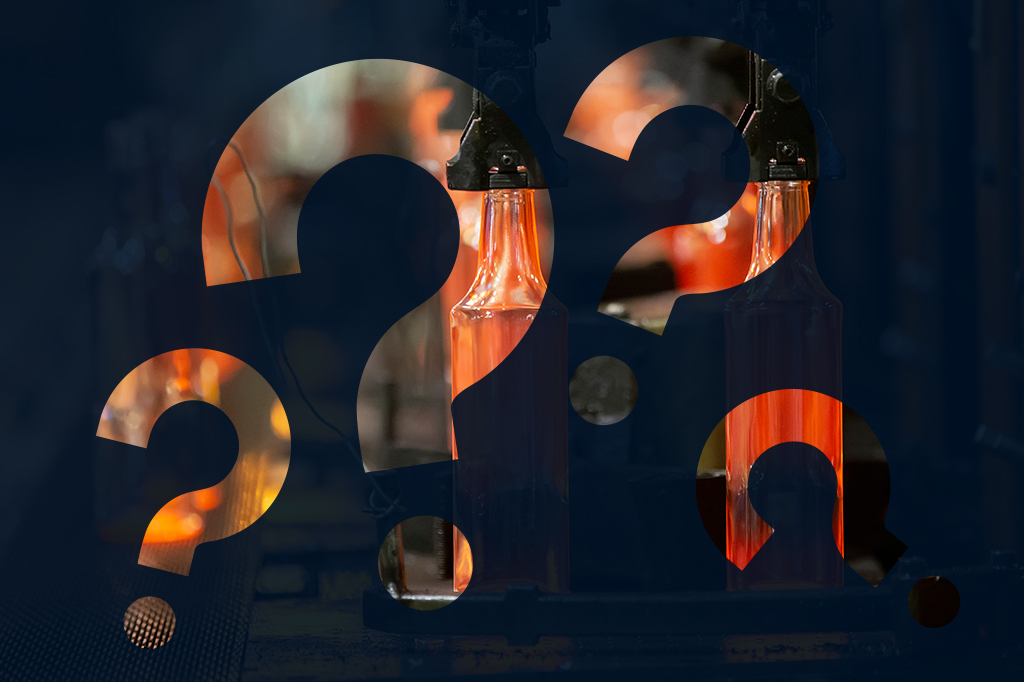Glass is endlessly recyclable, strong, safe for food and drink and one of the most sustainable packaging materials out there. Yet the science and craftsmanship behind it often go unnoticed.
So let’s put your knowledge to the test! Take our fun quiz, see how many answers you can get right and maybe even learn a few new facts along the way.
How It Works
- Pick A, B or C for each question
- Your score is revealed at the end

Quiz Time
1. What is “cullet” in glassmaking?
A) A protective coating for bottles
B) Broken or waste glass that gets recycled into new bottles and jars
C) A type of mould used in forming
Correct Answer: B
Why it matters: Cullet is simply recycled glass, and it’s gold dust for manufacturers. The more cullet used, the less energy a furnace needs, and the lower the carbon footprint of your bottles and jars.
2. How hot does a glass furnace usually run when making bottles and jars?
A) Around 900 °C
B) Between 1,350 and 1,600 °C
C) Over 2,000 °C
Correct Answer: B
Why it matters: Furnaces run at blistering heat often around 1,550 °C – to melt raw materials and cullet into a perfectly molten liquid. That’s hotter than lava!
3. What are the three key raw ingredients in soda-lime glass (the type used for most food and drink packaging)?
A) Silica (sand), soda ash, limestone
B) Clay, carbon, magnesium
C) Salt, gypsum, gravel
Correct Answer: A
Why it matters: This simple recipe – silica sand, soda ash, limestone has stood the test of time. Add cullet into the mix and you’ve got the perfect foundation for bottles and jars.
4. What does “annealing” mean in glass production?
A) Adding colour to the glass
B) Carefully cooling bottles and jars to remove stress
C) Crushing bottles into cullet
Correct Answer: B
Why it matters: When glass containers leave the mould, they’re still under stress. Annealing – passing them slowly through a hot “lehr” at around 500–700 °C – relaxes the glass so it’s strong enough for everyday use.
5. Why is cullet so valuable to the container glass industry?
A) It makes bottles weaker
B) It saves energy and cuts CO₂ emissions
C) It increases furnace wear
Correct Answer: B
Why it matters: Every 10% increase in cullet saves roughly 2–3% energy in the furnace. That’s a big win for sustainability and helps brands hit recycling targets.
6. Which forming methods shape molten glass into bottles and jars?
A) Blow-and-blow, and press-and-blow
B) Roll-and-pour, and dip-moulding
C) Spin-casting, and cut-moulding
Correct Answer: A
Why it matters: Narrow-neck bottles (like beer or wine) are made with the blow-and-blow method, while wide-mouth jars usually use press-and-blow. Both are precision processes that rely on moulds, air and exact timing.
7. At what temperature does the annealing process usually happen?
A) 100–200 °C
B) 500–700 °C
C) 1,200–1,400 °C
Correct Answer: B
Why it matters: Annealing lehrs typically run at around 550 °C – hot enough to relieve stress, cool enough to keep containers intact.
8. Which of these is NOT used in standard glass bottles and jars for food & drink?
A) Silica
B) Lead oxide
C) Soda ash
Correct Answer: B
Why it matters: Lead oxide is used in specialty crystal, not in food and drink containers. Bottles and jars are made from soda-lime glass, safe and endlessly recyclable.
9. Why is glass considered “infinitely recyclable”?
A) It loses quality after just a few cycles
B) It can be recycled endlessly without losing purity
C) It produces plastic by-products when recycled
Correct Answer: B
Why it matters: Unlike many packaging materials, glass never downgrades. A bottle recycled today could become another bottle — again and again, forever.
10. Roughly how much energy can be saved by adding 10% more cullet to the batch?
A) 0.5–1%
B) 2–3%
C) Around 10%
Correct Answer: B
Why it matters: It may sound small, but across thousands of tonnes of glass, those energy savings add up – reducing emissions and costs.
Your Results
Why This Matters for You
Choosing glass isn’t just about packaging – it’s about sustainability, brand image and protecting the quality of your product. At Glassworks International, we help food and drink companies find the right glass bottles and jars, whether you’re a global brand or a growing producer.
Want to learn more? Explore our website or get in touch – we’d love to help with your next packaging project.
Glassworks International takes pride in keeping up to date with the latest technologies and trends within glass manufacturing and production.